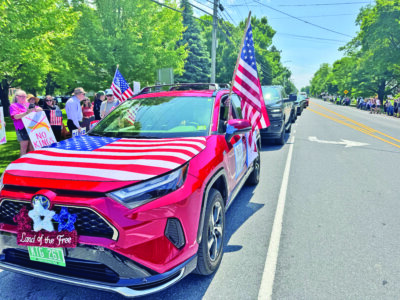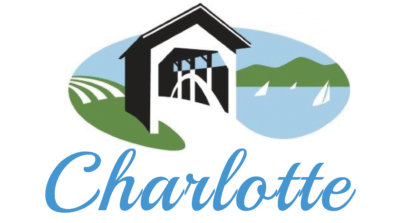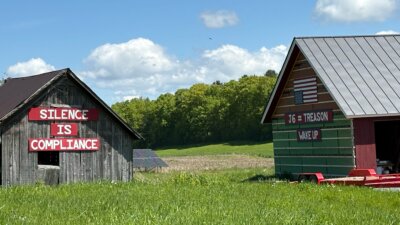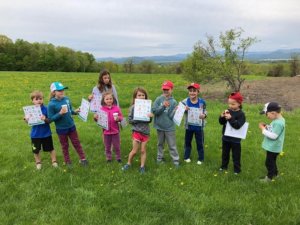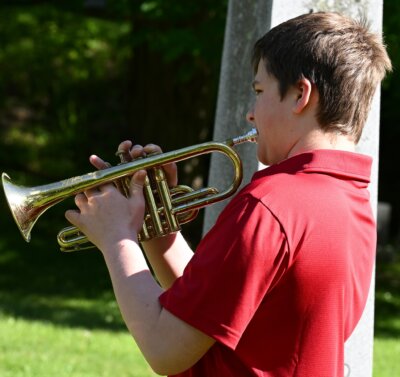East Charlotte residents fear VCS’s outdoor center plans
Neighbors say they hope the ZBA will curb school’s land use
Neighbors of the proposed Vermont Commons School (VCS) Outdoor Education Center have raised concerns that, absent zoning restrictions imposed by the town, the South Burlington school will transform their quiet, pastoral community into a noisy, chaotic hub for sports events, graduation ceremonies and other large school gatherings. Neighbor Sarah Thompson, 39, said even driveway access to her home has been put at risk by the school’s plans.
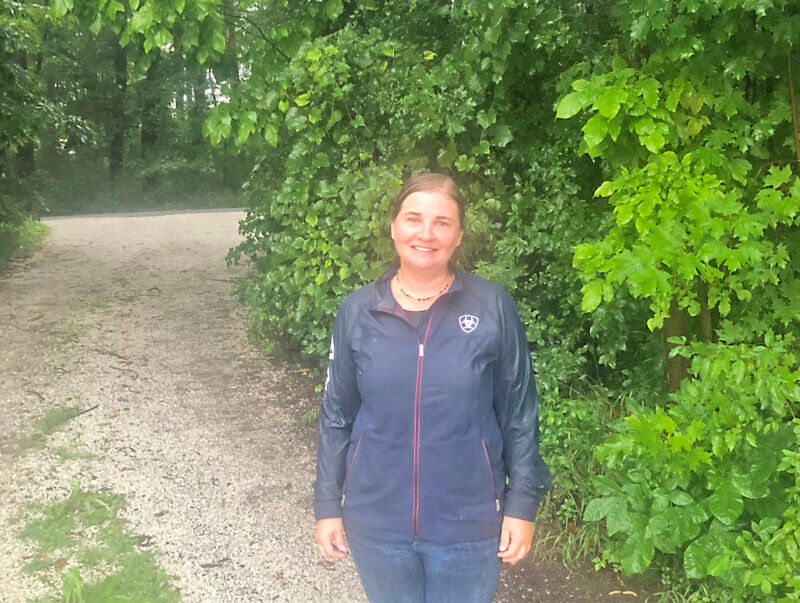
Thompson, a local high school science teacher, lives next door to the proposed outdoor center with her partner, Zeb Martin, and her four horses. She took over the property in 2012 following her mother’s death.
“I own a really narrow strip that equals 12 acres, and it’s only a few hundred feet wide—what they used to call a spaghetti lot—that borders the entire north portion of the 54 acres that the Vermont Commons school bought,” Thompson said. “Everything that [VCS] is going to do affects how enjoyable my property is.”
Late last year, VCS, which serves grades six through 12, presented the town with a site plan for the outdoor school center. In July, the Planning Commission granted VCS conditional approval with the caveat that a conditional use review by the Zoning Board would still be required. (On August 9, the Selectboard delayed approving a highway access permit for the school until the Zoning Board completes its review.)
Thompson’s mother Jane Dowd (later Jane Thompson) and first husband Ray Dowd purchased the “spaghetti lot” from Alma St. George in the 1970s. At the time, Dowd had an informal arrangement with St. George that she could use the driveway, which was on St. George’s land, to access her property.
“There was a farm access that used to be used as a driveway,” Thompson said. “So, technically, I enter my property from their land.”
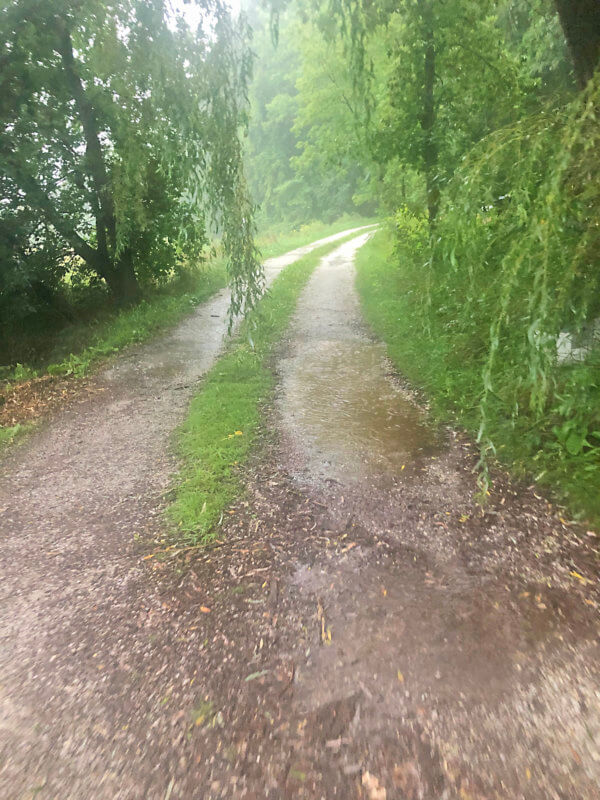
Before she died, Dowd Thompson tried to secure an easement for the driveway, but was unable to complete the process, Thompson said. So, when VCS purchased the property from St. George’s daughter Lucia Plante in September 2020, they purchased the driveway to Thompson’s property along with it.
“The fact that my land is so narrow and [VCS] is proposing basically an event site, and I don’t have a driveway, it’s sort of a nightmare,” Thompson said.
Thompson said after meeting with VCS Head of School Dexter Mahaffey last fall she was left with the impression that the school planned to use the site for occasional, small-scale activities.
“[Mahaffey] told us they wanted this to be an educational site, they wanted a small pavilion,” Thompson said. “He said that the kids might play some games and camp there three times a year. And we were like, ‘awesome.’”
Thompson said what she observed during the 2020 to 2021 school year seemed to align with Mahaffey’s representations.
“On Wednesdays I would see students on the property, taking measurements, collecting data, sometimes little meetings would be held, or the kids would play a little frisbee,” she said.
Thompson said she enjoyed seeing the students on the land and marveled at how they “were out there in all kinds of crazy weather, gathering data. I thought, that’s sort of cool.”
It was not until she saw the school’s official site plans that she realized VCS had a larger vision for the property than the “small, unintrusive” plans Mahaffey described in his conversations with her, Thompson said.
“Everything sort of went a little bit south for me when I got to see their first round of maps that they presented to the Planning Commission,” she said. “They had two large ultimate frisbee fields, a 40 by 80 pavilion, parking for 25 cars.”
But Mahaffey insisted the school never wavered in its plans for the site or how they represented those plans to the neighbors and the town.
“There is a sense that things had changed and that there was suddenness to this, and I think I would just have to say that none of this is new,” Mahaffey said. “Part of the challenge is that people maybe weren’t at a meeting or didn’t read the materials.”
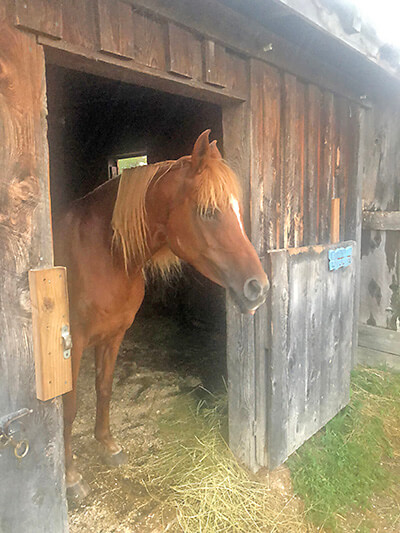
In a December 22, 2020 letter addressed to the town, a dozen East Charlotte neighbors raised concerns about the project, which they described as a “akin to opening Pandora’s Box.”
“Once playing fields are built, there is little the town or neighbors can do to limit their use,” the letter states. “At one point Dexter Mahaffey said that the fields would be for practice, then maybe a few games, and then perhaps the school would restart a soccer team. As you can see, once the fields are there, more uses will be found.”
The letter also raised environmental concerns.
“This field is also connected to the wildlife corridor and often is a feeding ground for deer, bobcats, coyotes, fox and the random bear and moose,” the neighbors asserted.
Thompson said if she and her horses cannot live peacefully on the property, she will be forced to leave the only town she has ever called home.
“I wouldn’t be able to stay in Charlotte,” she said. “The only reason I’m living here is because my mom spent her life paying for [this property].”
She described her predicament as “the ultimate Charlotte dilemma.”
“It’s the little guy versus the big guy,” she said.
Thompson said she has asked the school for “three things: protected driveway access, protection for the horses, and some sort of reasonable time of use.”
“They own [the land] and I get that,” she said. “But [the proposed activities] are totally out of character with the neighborhood.”
Mahaffey disagreed that the activities described in the site plan will change the character of the neighborhood or disrupt local wildlife.
“When you talk about hunting, chainsaws, logging operations, woodlot operations, tilling, farming, excavation—businesses that are already in the area—it’s pretty clear that we’re not talking about a new expanded noise disruption that would cause problems for wildlife.” Mahaffey said.
The only large-scale events planned by the school, Mahaffey said, are an annual fall bonfire for approximately 100 people, and a graduation ceremony in June, which draws about 200 attendees.
“I live on a farm in Charlotte, fewer than five minutes away, so I am the neighborhood,” Mahaffey said. “And if a neighbor came to me and said, ‘We want to hold a wedding and it’s going to be on a Friday night and there’s going to be a band, is that okay?’ I would say ‘of course.’ I wouldn’t even blink.”
But according to Mahaffey and the site sketch plan, the school is planning additional large (130+ people) events at the property, including an “all-school” Orientation Day in August from 8:30 a.m. to 5:30 p.m. and another all-school Field Day in June.
“But those are the only four large community events that we are and have been talking about at any point,” he said.
As for smaller events, Mahaffey said the school hopes to hold soccer, volleyball and ultimate frisbee practices at the site after school five days a week, from 3:30 to 5:00 p.m. in September and October, and again in April and May. The practices would consist of approximately 30 to 40 middle and high school students plus coaching staff.
The May schedule might also include up to five Ultimate Frisbee games with approximately 70 people attending, Mahaffey said.
For Thompson, that schedule translates into disruption to her property on a regular, sometimes daily, basis. One of her primary concerns, she said, is for the safety of her horses and that of the students who might try to approach them.
“So far [on the school property], it’s been kids and teachers walking, doing measurements, and the horses have been aware and wary, but they’ve been fine,” Thompson said. “But when they start bringing in cars, and music and graduation, and the games, the sports, the yelling and screaming…” her voice trailed off.
“I work with teenagers, I know what a pavilion of students sounds like,” she said.
Thompson also expressed concerns that students could injure themselves on the electric fence that borders her property. She said she told Mahaffey students should be made aware of the risk.
Aside from the disruption to her property and driveway access, Thompson is also worried about sharing the driveway with multiple school buses, student drivers and other vehicles. At the August 9 Selectboard meeting, residents and Selectboard member Louise McCarren echoed Thompson’s concerns. Road Commissioner Jr Lewis suggested widening the proposed highway access point and removing two existing trees, which VCS agreed to do.
Thompson said widening the driveway will not solve the safety issues.
“It’s an adequate driveway for a household of two mature drivers,” Thompson said. “It is not an adequate driveway, even with the maintenance, for a shared business entity and a household. I’ve lived here my entire life and that driveway is dangerous.”
Thompson said there is ample space on the school’s property to create a second curb cut, which would solve both safety and access issues.
“There are at least a hundred feet where a driveway could go,” she said.
Mahaffey said the driveway situation is not as bad as some neighbors are making it out to be. He pointed out that many VCS students are not old enough to drive and that not all student drivers can afford their own vehicles.
Transportation for the practice games would be provided by two VCS passenger buses and “eight or 10 personal cars at most,” he said.
When asked if VCS would consider creating a second curb cut to give Thompson sole use of the driveway her family has used for more than 40 years, Mahaffey demurred.
“I think we have to let the folks reviewing the highway access permit weigh in on what they think is the best for the properties, what they think is the best for the town,” he said.
Mahaffey said VCS will do whatever the town decides is in the community’s best interests.
“If the community, through our governance that we collectively put together, says, ‘Here’s what’s going to work and not work for the property,’ we will comply with that,” he said. “We don’t want to make our neighbors miserable. We want to work with everybody.”
He said the school intends to submit its conditional use application to the ZBA early this month.
“We don’t want it to drag on any more than it has to,” he said. “The flip side of that is we also know that the town and the neighbors may need to take their time, and we will be responsive and receptive to as long a time as people need to take because we want to get it right. We’re in it for the long haul.”
At press time, Thompson updated The Charlotte News via email that she and the Vermont Commons School are in negotiations to resolve the right of way issue.
The Charlotte News publisher John Quinney was one of the 12 residents who signed a December 22, 2020 letter to the town opposing the Vermont Commons School Outdoor Education Center. Mr. Quinney was not involved with the reporting of this story.
Related Stories
Popular Stories
If you enjoy The Charlotte News, please consider making a donation. Your gift will help us produce more stories like this. The majority of our budget comes from charitable contributions. Your gift helps sustain The Charlotte News, keeping it a free service for everyone in town. Thank you.
Andrew Zehner, Board Chair



